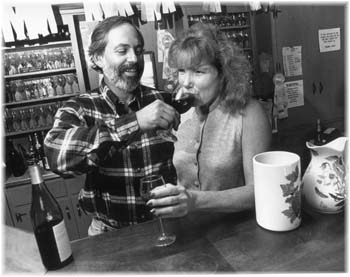![[MetroActive Dining]](/dining/gifs/dining468.gif)
[ Dining Index | Metro Santa Cruz | MetroActive Central | Archives ]
The Sip of Fools
| |

Robert Scheer
Lip Service: Vintners Chuck and Cheryl Devlin know the fine art of wine tasting--they expertly swill and sample one of their Devlin Winery's 1994 Central Coasts Syrah in their Soquel tasting room.
Wine tasting is one of those activities that used to liquidate the leisure time of snobs, landed gentry and people with French accents back in the days before MTV and the Web
By Christina Waters
EVEN TODAY, RIGHT HERE in a landscape positively riddled with winemaking operations, the word "tasting room" strikes terror--or laughter--in the hearts of ordinary people. What we want to do right now is face that fear, examine it and defuse its power to render us stupid.
Tasting rooms are simply show-and-tell counters where potential wine lovers--connoisseurs of the future, if you will--can sample, learn and expand their palates before they buy.
I mean, if you're making dinner for someone special and want to buy a nice wine to go with that seafood pasta, you can always run out to your local liquor store.
But what will you find? Hundreds and hundreds of choices of chardonnays, cabernets, merlots, sauvignons--from wineries you've never heard of.
Are they any good? How do you know you're not simply throwing away your $20 on designer swill?
Aha! That's exactly why God invented tasting rooms. To help arm you with knowledge and a bit of expertise.
When you do taste something you like, remember it--better yet, buy a few bottles right then and there--and you'll be able to approach the aisles of Shopper's Corner or Trader Joe's without resorting to Prozac.
![[line]](/gifs/line.gif)
Santa Cruz wineries to swirl, sniff and sip sweet stuff.
![[line]](/gifs/line.gif)
Tasting Rooms Are Our Pals
Tasting rooms are the sales arm of the winery. Therefore, the people who staff them are happy to explain stuff to you--it's their job. So don't be intimidated by all the bottles and names. Remember those guys who do ratings for the Wine Spectator had to start somewhere.
Tasting room people love to talk about wine--especially to newcomers. They think of themselves as priests of the grape. You are the new initiates, coming to take part in an important rite of passage. Besides, if they do their job well, you will become the devotées (i.e. consumers) of tomorrow. The better they do their job, the more wine you'll eventually enjoy--and purchase.
Not long ago, all tasting rooms were happy to pour samples on a complimentary basis. Today, you can expect to be charged a nominal fee for your pour. Since you will have access to quite a few open bottles, it's still a good deal. An hour's tasting will also give you a delicious overview of a particular winery's style and strength.
Ask questions. This tactic bears repeating. Ask questions. If you cannot pronounce the name on the label, ask for guidance. If you're unsure about what constitutes the difference between red and white wines (other than the color, of course) don't hesitate to ask. Winery representatives love to show off their knowledge of such terms as skin contact, malolactic fermentation and racking. Let them show off. You'll learn a lot.
In a professional tasting situation, a half-dozen or so varieties of wine will be available for tasting--three whites and three reds are usual. These will be offered to you, each in its own separate glass, starting with the whites, the driest ones first. This is to help keep your infant palate from getting overstressed. The bigger and fruitier the wine, the more impact on the
tastebuds. Therefore it's best to begin with the light ones and move on to the dark ones (with apologies to Tennessee Williams).
Now for the most important tip you can learn. Do not attempt to actually swallow all of the wine poured for you. You will become sloshed and lose the ability (among others) to tell the wines apart.
Use the dump buckets provided to spit out the wine you've tasted. This part is a bit tricky, since we were all brought up to not spit in public. And, yes, it feels awkward at first. But once you realize that you can actually work through a dozen wines and still keep a clear head, you'll be a true believer.
Basic Tasting
Swirl: Once the wine is poured, gently move your wineglass in a circular fashion so that the wine swirls around. Mixing the wine with air in this way helps to release the full fragrance, called "nose."
Sniff: Tons of important information about taste is revealed through the nose, so once your wine has "opened" through swirling, stick your nose deep into that glass and inhale the gorgeous aromas. (At professional tastings, most of the action involves people sticking their noses into glassware.)
Sip: Now you're ready to actually take a small sip of wine. Swish it around in your mouth--don't be afraid to make gurgling sounds. Chew it a bit to mix more air with the liquid. Check out where the flavors are occurring in your mouth. Try to identify the features of that flavor: fruit (cherries, plums, citrus)--maybe spice?--even hints of olive, leather and tobacco. Let your imagination work. And then, spit. You can learn all you need about the distinctive features of a specific wine without swallowing. And you'll stay a lot fresher for the next wine to be discovered.
You will not like every single wine you sample. You will like some of them. A lot. Ideally, you'll meet some new varietal you never expected.
By learning more about wines, you've expanded your own enjoyment, tasting skill and pleasure in pairing foods with their natural partner.
You know what to do now.
[ Metro Santa Cruz | MetroActive Central | Archives ]
|
From the Oct. 23-29, 1997 issue of Metro Santa Cruz.
Copyright © Metro Publishing Inc. Maintained by Boulevards New Media.

![[line]](/gifs/line.gif)
![[line]](/gifs/line.gif)
![[MetroActive Dining]](/dining/gifs/dining468.gif)